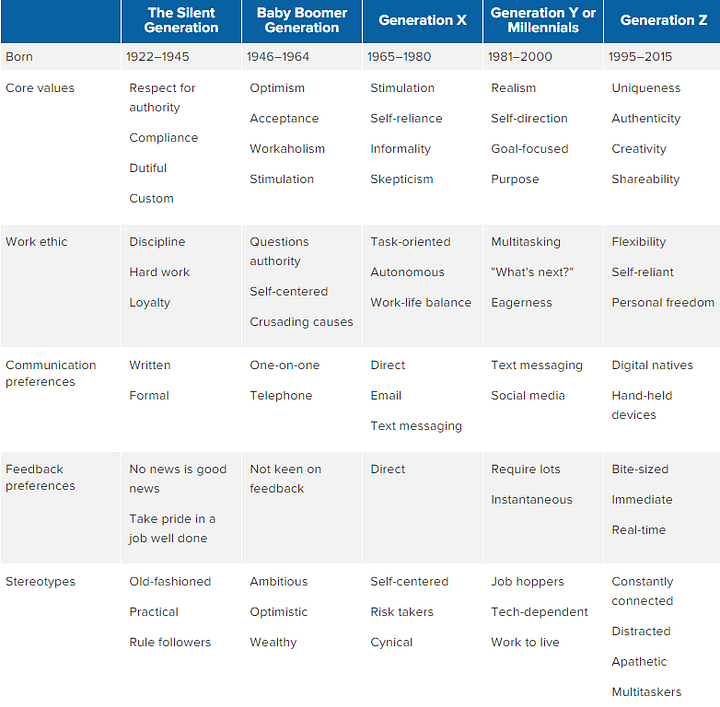
Differences can be an advantage, but you first have to perceive them that way.
A Time magazine article titled “Millennials: The Me Me Me Generation” opens with the line:
“I am about to do what old people have done throughout history: call those younger than me lazy, entitled, selfish and shallow.”
That very same article goes on to describe Millennials as “earnest and optimistic. They embrace the system. They are pragmatic idealists, tinkerers more than dreamers, life hackers.”
According to the Society for Human Resource Management, there exist five different generations in the job market today. Each generation differs in style, values, experiences, and attitudes.
Executives should be conscious of this variety. You may find yourself asking, but why? Isn’t this an HR matter?
Well, not only. The matter of fact is that every individual, especially executives, should be aware of the overarching generational differences that exist so they can take them into account and plan for them. Not doing so will have organizations missing out on each generations’ strengths, inadvertently reinforcing their weaknesses, or worse yet-seeing top talent walk out the door as a result of being misunderstood.
Leaders need to learn how to speak to each generation.
The following table concisely covers various generational differences. It is a broad generalization, but that being said, is often true.

(Source: Mindtools.com)
“Having a multi-generational workforce can, and should, be a distinct advantage for companies today. The wide range of ideas and knowledge from a broad group of people can actually serve the company well, and help employees excel in their work” (Forbes).
A diverse workplace can serve as a competitive advantage. However, if managers and employees don’t understand each other, their differences can lead to miscommunication and barriers.
Establishing multi-generational accord
In order to reap the benefits of a multi-generational workforce, keep the following simple tips in mind.
1. Be flexible and tailor your communication style
While you shouldn’t stereotype, you should be aware of overarching generational differences. Understanding what makes each generation tick will help you get along better. Generally speaking, different generations have different preferences.
One particular way they tend to differ is in their preferred modes of communication. Should you go for in-person, text, or written communication? Is it best to give lots of feedback or as little as possible? Your answers should differ depending on who you’re talking to. Tailoring your communication style to your audience will help ensure that your message gets across.
2. Recognize commonalities and shared goals
We’re all human, and we all have aspirations, goals, and needs.
Emphasizing shared goals will help create group cohesion. Having a shared vision will have older and younger employees alike seeing themselves as part of the same team working toward the same outcome. Indeed, focusing on commonalities or a common direction can reduce perceptions of “us” versus “them” and reinforce a sense of “we.”
This needs to be top-down, with the executive team leading the way.
One way to encourage intergenerational collaboration is by adopting technologies that support this such as Datarails. With Datarails, intergenerational finance teams can access and leverage financial and operational data independently regardless of technical competency. This means that both technologically-challenged baby boomers and Millennial tech natives alike can work together, in harmony, with the same toolbox.
Datarails allows professionals to share files and message teammates directly from their spreadsheets. Because of its built-in version control, all updates are received in real-time by all team members. This collaborative work in real-time can help reinforce a sense of togetherness.
3. Avoid stereotyping
It’s encouraged to recognize differences, but not rely on them. It’s easy to fall into the trap of stereotyping since that’s just how our mind is built- we rely on categorizations to make sense of the world. But categorizations, biases, and heuristics aren’t always helpful.
There is evidence that suggests that sometimes differences in preferences and values between generations are actually quite small. In fact, according to the Harvard Business Review there is often considerable variety of preferences and values within each of these groups.
It’s important to understand that each generation grew up and was molded in a different period of time with different societal and cultural influences. That being said, just because sociologically some generalizations may be true, does not mean that they always hold true.
“Can you imagine how many frickin’ Instagrams of people playing in the mud during Woodstock we would’ve seen? I think in many ways you’re blaming millennials for the technology that happens to exist right now.”
The words above were spoken by Scott Hess, senior vice president of human intelligence at SparkSMG. His point is this- sometimes we attribute external factors, for example the tendency to take selfies, to internal factors, like narcissism, when in fact narcissism is not the cause. In psychology this is called the fundamental attribution error, an error we tend to make quite a lot.
“Not all Millennials think alike. A demographic is not a psychographic.”
-Andy Dunn
Same same, but (slightly) different
The intergenerational workforce can be an asset. But first, the executive team must make sure that this is the message they are sending throughout the organization.
Understanding generational differences and designing an organizational culture and structure that embraces differences will allow businesses to capitalize on the strengths of each age group.
About Datarails
Datarails is a FP&A software that empowers each finance professional to independently work with data and deliver actionable, data-driven insights. Finally, count on numbers you can trust and reduce inefficiencies without having to change how you work on Excel. With Datarails, strengthen the connection between finance and operations to drive better organizational decisions.